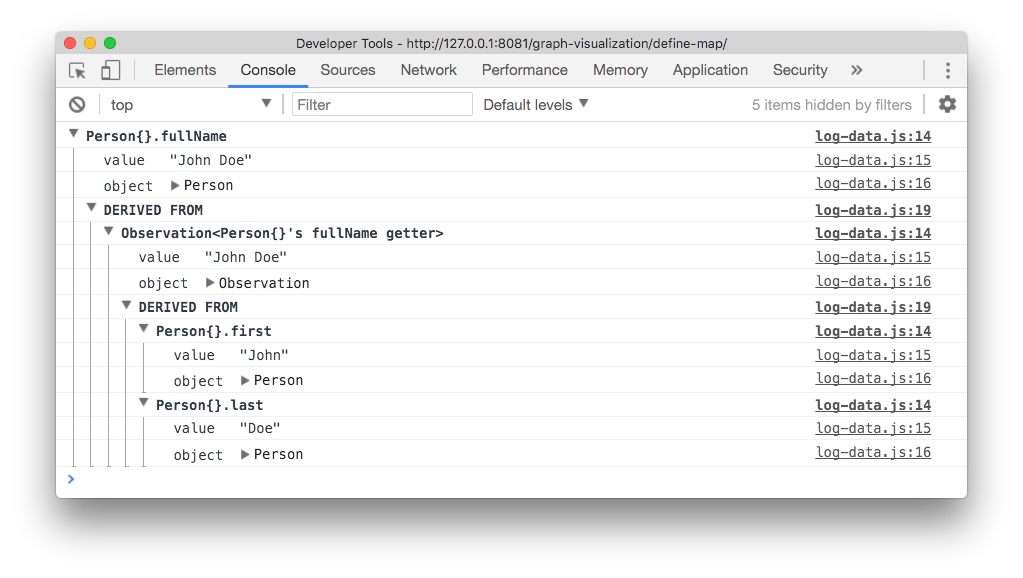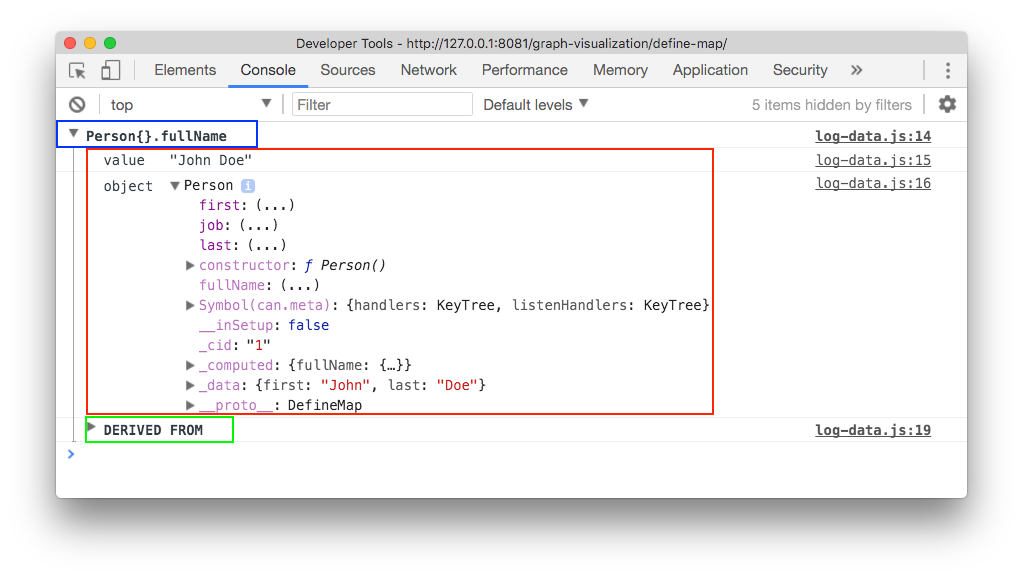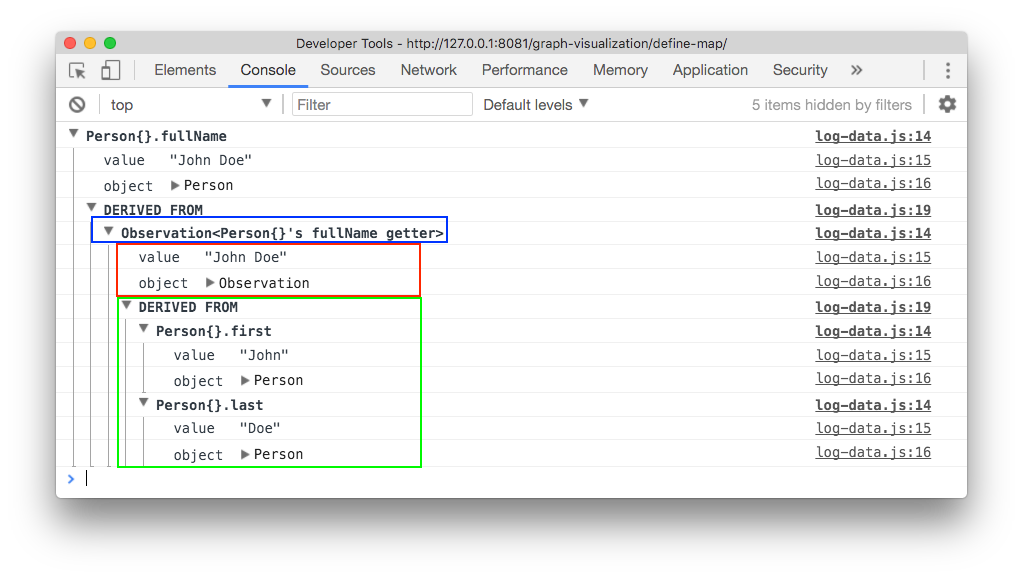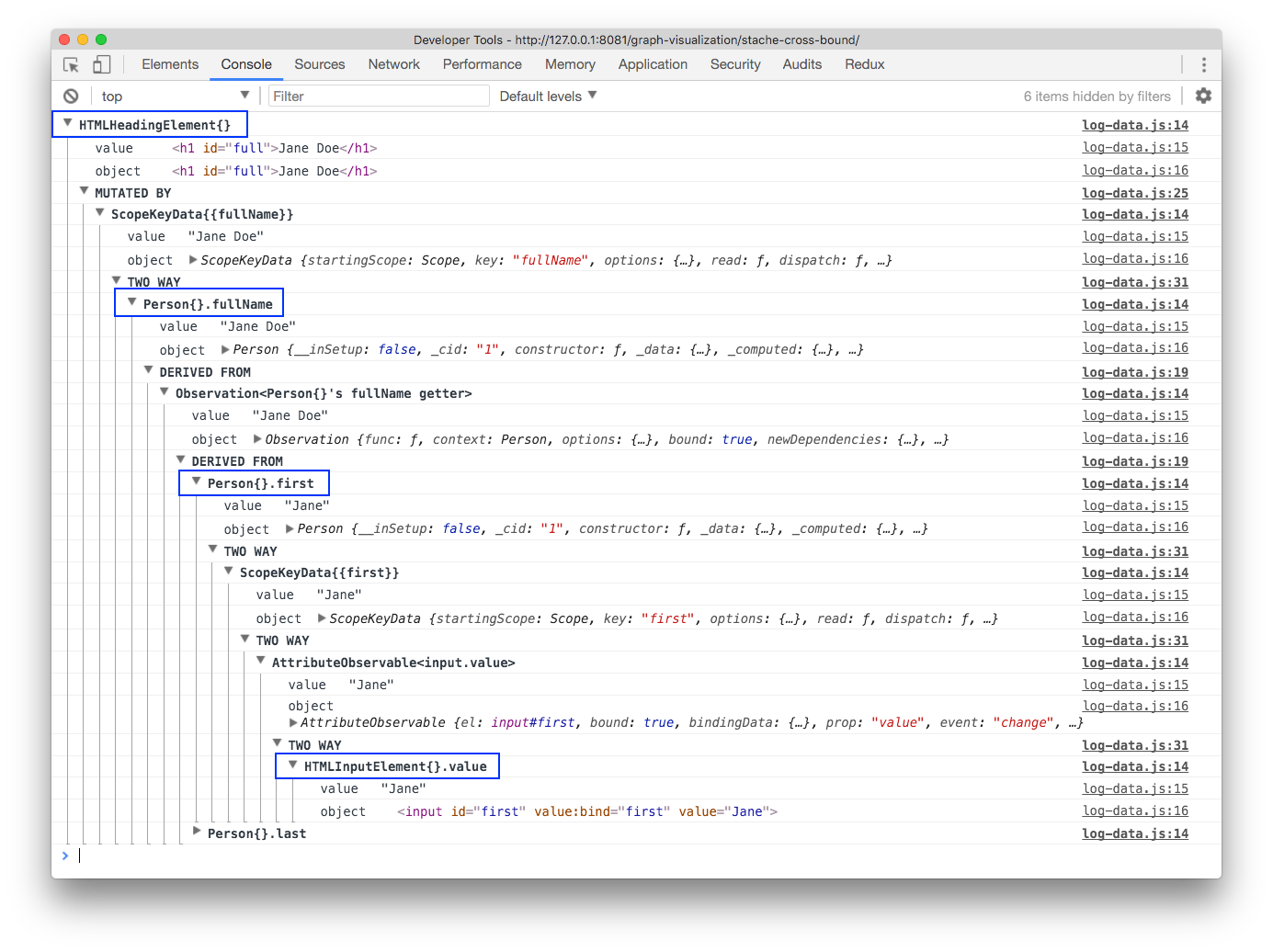can-debug
Useful debugging utilities.
Object
can-debug provides methods that show how different parts of an application
affect each other, specifically CanJS's observables and DOM nodes.
Exports an object with the following methods:
{
drawGraph // Draws the dependency graph in a new window
logWhatIChange // Log what the observable affects
logWhatChangesMe // Log what affects the observable
}
Use
can-debug exports functions to log how observables affect each other. These
functions can be used to understand the flow of data throughout an application.
The following example shows how to use the logWhatChangesMe function
to log what affects the value of the fullName property on the me Person instance.
const Person = DefineMap.extend( "Person", {
first: "string",
last: "string",
fullName: {
get: function() {
return this.first + " " + this.last;
}
}
} );
const me = new Person( { first: "John", last: "Doe" } );
debug.logWhatChangesMe( me, "fullName" );
Which prints out the following message to the browser's console:

At first, the message might be very confusing, specially so in larger examples where multiple observables are involved. Let's break it up in smaller sections to get a better understanding of what each means:

The following values are printed out for each observable in the dependency graph:
- The observable's human-readable name in the blue border box,
- The observable's value and object reference in the red border box,
- And finally the observable's dependencies in the green border box.
Each observable will be contained in a console group, this group is labeled using a human-readable name that describes what the the observable does (blue border box), in most cases this name is made out of the constructor name decorated with some metadata and it's returned by getName.
The box with the green border lists the dependencies of the observable in the
blue border box, these dependencies are grouped based on their relation to the
parent observable, in its current version can-debug outputs the following
groups:
- DERIVED FROM: observables used internally by the parent to derive its value.
- MUTATED BY: observables that set the value of the parent observable these are mostly found inside CanJS internals, where observables interact with each other, like can-stache-bindings.
- TWO WAY: observables that are both derived and mutation dependencies.
The observables in each group are printed out recursively using the same format we
just described, We can can confirm this by expanding Person{}.fullName's dependencies
group:

The whole output can be read as:
Person{}.fullName derives its value from Observation<Person{}'s fullName getter>,
which in turn derive its value from Person{}.first and Person{}.last values.
Note: Please keep in mind that some of the observables printed out in the console do not necessarily match the ones found in user's application code, as mentioned before, observables used internally are listed as dependencies, such is the case of
Observation<Person{}'s fullName getter>in the example.
The following demos a live version of the previous example, click the logWhatChangesMe
button and open the browser's console tab to inspect the generated message:
Understanding the relationships between types is helpful to debug certain kind of issues, but most of the time you want to understand what affects another kind of observables: DOM nodes.
The following example builds upon the previous code, and adds two <input> elements
that are cross bound to the first and last properties of the Person map, then
fullName is printed out in the page using a <h1> element.
Then logWhatChangesMe is called to log what observables affect the
<h1> element:
const Person = DefineMap.extend( "Person", {
first: "string",
last: "string",
fullName: {
get() {
return `${this.first} ${this.last}`;
}
}
} );
const template = stache( `
<h1 id="full">{{fullName}}</h1>
<input id="first" value:bind="first">
<input id="last" value:bind="last">
` );
const scope = new Person( { first: "Jane", last: "Doe" } );
document.body.appendChild( template( scope ) );
debug.logWhatChangeMe( document.querySelect( "#full" ) );
This prints out the following message:

That's a long message! but once you have identified the output pattern, making sense
of it is a lot easier. The observables highlighted in blue border boxes are the most
important to get a high level overview of the dependency graph, while the observables
in between help you make sense of how data flows from the top <h1> element down to
each <input> element and back up to the <h1> heading element.
The following demos a live version of the previous example, click the logWhatChangesMe
button and open the browser's console tab to inspect the generated message:
How to write can-debug friendly code
CanJS's internal observables are decorated with metadata and symbols used by
can-debug to build the dependency graph.
For most CanJS applications, the default instrumentation should be enough to get
reliable logs from can-debug; but custom observable types require some extra
work to make them easier to debug.
The whole process can be sumarized in the following steps:
- Give the observable a human-readable name, check out getName docs.
- Register how the observable interacts with other observables, check out can-reflect-dependencies docs.